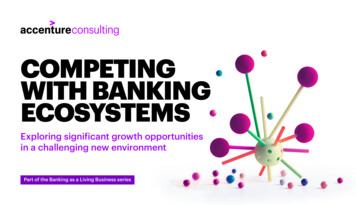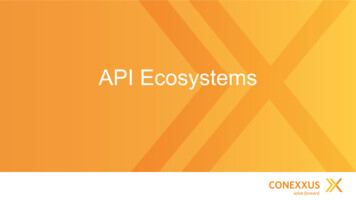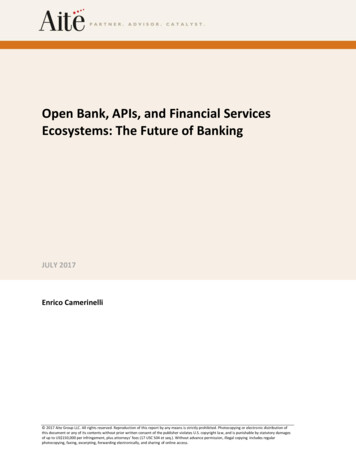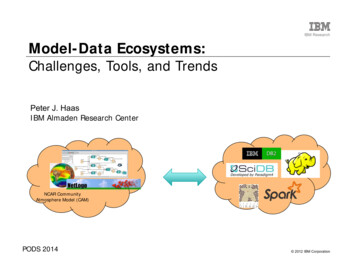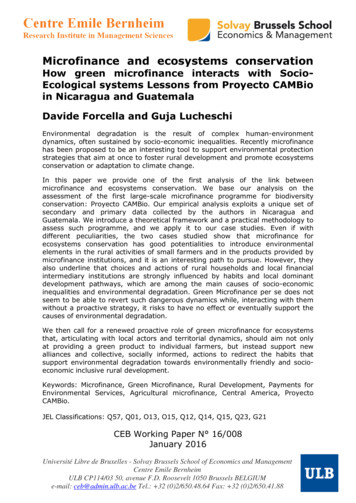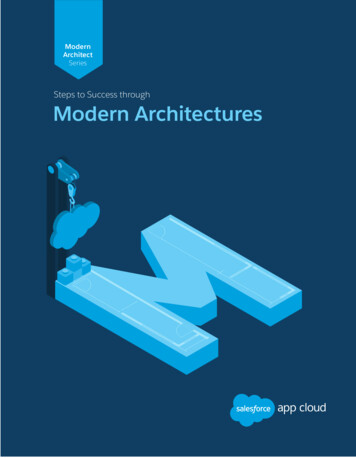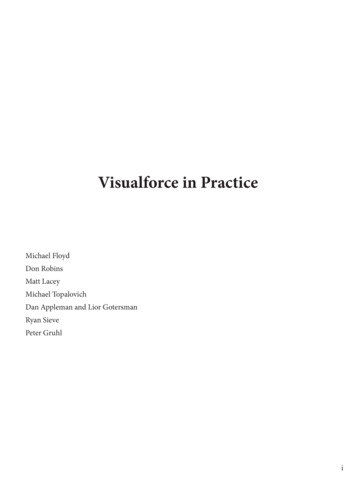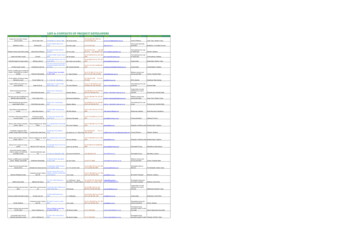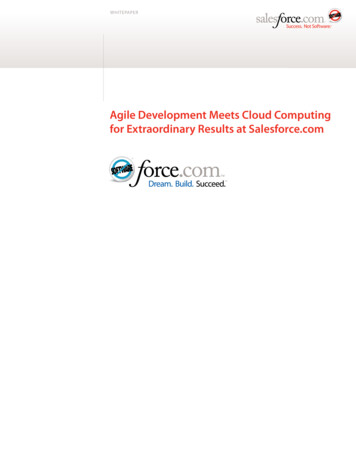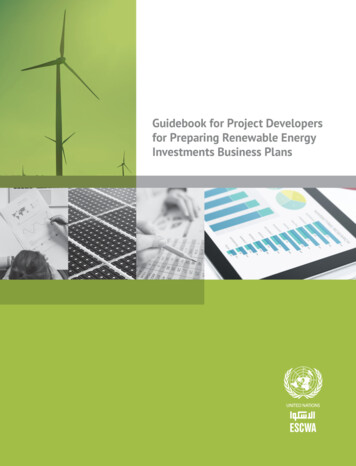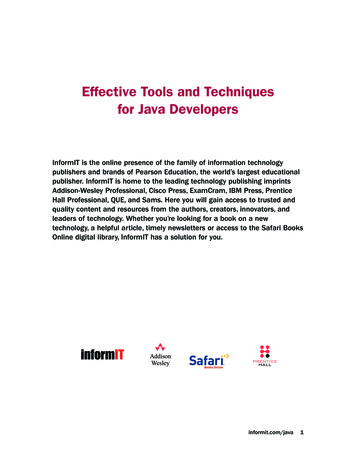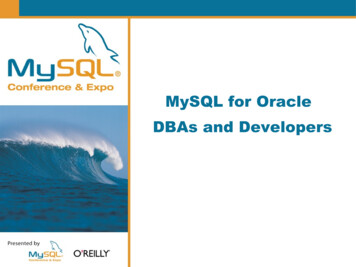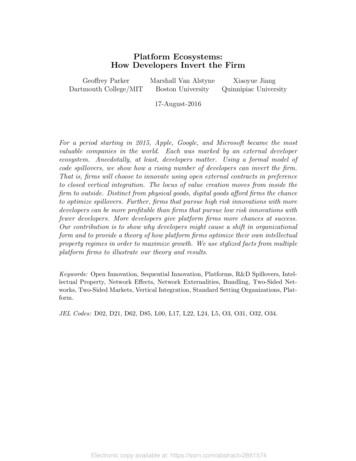
Transcription
Platform Ecosystems:How Developers Invert the FirmGeo rey ParkerMarshall Van AlstyneDartmouth College/MITBoston UniversityXiaoyue JiangQuinnipiac University17-August-2016For a period starting in 2015, Apple, Google, and Microsoft became the mostvaluable companies in the world. Each was marked by an external developerecosystem. Anecdotally, at least, developers matter. Using a formal model ofcode spillovers, we show how a rising number of developers can invert the firm.That is, firms will choose to innovate using open external contracts in preferenceto closed vertical integration. The locus of value creation moves from inside thefirm to outside. Distinct from physical goods, digital goods a ord firms the chanceto optimize spillovers. Further, firms that pursue high risk innovations with moredevelopers can be more profitable than firms that pursue low risk innovations withfewer developers. More developers give platform firms more chances at success.Our contribution is to show why developers might cause a shift in organizationalform and to provide a theory of how platform firms optimize their own intellectualproperty regimes in order to maximize growth. We use stylized facts from multipleplatform firms to illustrate our theory and results.Keywords: Open Innovation, Sequential Innovation, Platforms, R&D Spillovers, Intellectual Property, Network E ects, Network Externalities, Bundling, Two-Sided Networks, Two-Sided Markets, Vertical Integration, Standard Setting Organizations, Platform.JEL Codes: D02, D21, D62, D85, L00, L17, L22, L24, L5, O3, O31, O32, O34.Electronic copy available at: https://ssrn.com/abstract 2861574
1Introduction and BackgroundOne of the most important questions a firm can ask is how to efficiently create value: shouldit produce its own output or should it orchestrate the output of others. In the case of code,the choice increasingly favors orchestration over production. Apple, Google, and Microsoft,for example, became the three most valuable companies in the world in 2015, having passedenergy and investment firms Exxon-Mobile and Berkshire-Hathaway.1We argue that developer communities are inverting the firm. That is, firms must nowmanage value creation that occurs externally just as carefully as they manage the valuethey create internally. And, this is not just outsourcing. Firms are relinquishing productspecifications to third parties that they do not even know. We provide a formal theoryof why this is happening and ask what levers platform firms have to encourage externaldevelopers to innovate on their behalf. Our particular focus is on digital innovations thatdevelopers create to extend platforms. Digital platforms di er from physical systems suchas automobiles because the subsystem boundaries can be more loosely defined, which makesrecombination of elements less costly, and because information is non-rival. Reusable code,for example, facilitates knowledge spillovers. Interestingly, however, even firms that produceproduct platforms such as automobiles, tractors, and turbines are adding a digital layer tocreate an Internet of Things (Evans and Annunziata, 2012).The role of developers has become so central in digital ecosystems that firms have developed strategies for “platform evangelism” to manage third party contributions that havebecome central to platform success.2 Reasons that developers are so important in digitalplatforms include well known features of digital technology such as malleability of the code,1http://finance.google.com. Accessed 9 Nov. 2015.The Open Automotive Alliance?s mission statement provides an example of the trend towards digitalinnovation on top of physical products: “The members of the Open Automotive Alliance share a vision forthe connected car, and are committed to collaborating around a common platform to make this vision areality.” http://www.openautoalliance.net/. Accessed 9 Nov. 2015.21Electronic copy available at: https://ssrn.com/abstract 2861574
the low cost of investing in tools to develop code, close to zero cost reproduction, and thepotential to profit from application successes while shedding the costs of failures. Put morebroadly, developers are key to a platform?s ability to scale rapidly because what the platformfirm does is not limited by the processes of hiring, training, project selection, and coordination. Instead, these processes are distributed outside of the platform, allowing much morerapid growth (Parker et al., 2016).Others have observed the importance of digital ecosystems and the strategies that firmshave to seek advantage. In an agenda setting paper for the field, Yoo et al. (2010) note thatfirms need to ask what they should open and what they should close in a digital productplatform. Kallinikos et al. (2013) adopt the term “digital artifact” and characterize digitalobjects as open, reprogrammable, and accessible by other digital objects.We are far from alone in observing that an historic shift is underway, driven by rapid improvements in network connectivity and computing power (Brynjolfsson and McAfee, 2014).Earlier improvements in transportation technology changed the locus of economic activityfrom vertically integrated firms to firms organized around a nexus of supplier networks. Webelieve that the current shift goes farther still. Using loosely affiliated ecosystems, firms areable to harness a global network of partners they don’t even know beforehand who can connect through digital networks to innovate on top of a core set of resources thereby creatinghighly valuable products and services for their users.In our context, a relevant innovation is any digital application, including a product orservice, that is produced by an ecosystem partner using core platform resources. The rateof innovation is the rate at which developers produces digital applications for the platform.A platform can be conceived as a “layered architecture of digital technology” (Yoo et al.,2010). This includes a device layer, network layer, service layer and content layer. To thisdefinition, we also add the governance rules that organize the ecosystem. The platform ownerthen influences developer innovation by exposing more platform resources e.g. by opening2Electronic copy available at: https://ssrn.com/abstract 2861574
the architecture (APIs, SDKs, code libraries, templates, etc.), and by o ering more favorablestandard licensing agreements (SLAs), e.g. by o ering exclusivity for new apps.Total Number of Apps by App StoreAverage selling price (and gap) ofiOS and Android smartphonesworldwideiOSAndroidiTunesGoogle Play1,5000 kPrice Gap1,250 k 702 261 441 710 330 380 686 366 320 650 3741,000 k750k b) The more open system grows faster.Source: AppFigures.(a) The more open system has the lower price.Source: Statista using IDC data.Figure 1: Openness entails a tradeo . It nets less revenue on the core platform but fostersmore applications development.The battle between Apple iOS and Google Android provides a useful example of different platform choices around layered architecture and openness. Although Apple courtsthird party developers, it remains a relatively closed system along the dimensions cataloguedin Eisenmann et al. (2009). For example, developers who wish to publish iOS applicationsmust submit to Apple’s rigorous quality review and Apple controls the only distributionchannel. Eaton et al. (2015) describe the tensions between Apple, developers who build ontop of iOS, and its end-users many of whom have “bricked” their devices in order to gainaccess to apps outside Apple’s control. In contrast, Google has released Android under anopen source license and has attracted more developer attention even though it launched afteriOS.3 Google’s Android system is open to hardware manufacturers to the point that Googlepublished reference designs to reduce their fixed costs in creating Android handsets (McAllister, 2011). To retain modest control over Android, Google makes API access dependentupon a Google Play subscription (Amadeo, 2013). Parker and Van Alstyne (2014) describethe strategic challenges such firms face when competing as platform ore-sales-google-play-android3
The di erent decisions have led to di erent market outcomes for both the price eachplatform charges and the number of applications provided by developers. As Figure 1ashows, the closed Apple platform is able to charge higher prices for the core platform, givingApple much higher margins. By contrast, Figure 1b shows that the more open Androidplatform has attracted more applications development. The number of Android apps passedthose of Apple iOS in 2014. Openness therefore entails a tradeo . It nets less revenue onthe core platform but fosters more applications development.The need to open a platform to facilitate developer innovation is nicely stated by Laursenand Salter (2014): “. in order to obtain knowledge, organizations have to reveal some partsof their own knowledge to external actors” (page 868). In e ect, this argues for the benefitof knowledge spillovers. Attaching to and building on others’ ideas is easier conditionalon access to these ideas. Importantly, in the case of software, Eilhard and Ménière (2009)provide empirical evidence that open code produces significant knowledge spillovers. In astudy of 10,553 open source projects on SourceForge, they find evidence of non-decreasingreturns to scale. Productivity of developers rises substantially with access to code libraries,especially if modules use the same language. The decision to fold new private code back intoan existing public code library thus represents a design parameter of a healthy ecosystem.Unsurprisingly, given the complexity of platform markets, executives struggle and havedisagreed over how to manage their developer ecosystems (Libert et al., 2014). At the closedend of the spectrum, Tivo used provisions of the Digital Millennium Copyright Act to lock outindustry players who sought to attach to its proprietary systems (Slater and Schoen, 2006).This allowed Tivo to charge more for its innovations. However, closure kept its ecosystemsmall. Ironically, the iPhone was also completely closed when Apple introduced it in 2007.Not until hackers broke into it in order to add new features did Apple release an approvedSystem Development Kit (SDK) (Eaton et al., 2015). At the open end of the spectrum, UNIXfirms have lost control over Application Programming Interfaces (APIs) to committees and4
have reduced pricing power as a result (West, 2003). RedHat, for example, uses standardGNU Public License terms that give anyone who receives their code the right to modify anddistribute copies of the enhanced code for free. This fosters ecosystem participation, butcompetitors promptly absorb all valuable innovations.Based upon our interviews with the global heads of platforms at Cisco, Haier, SAP, andThomson Reuters, we examine two key decisions that platform managers must make. Theseare (1) how much of the core platform to open in order to spur developer innovation and (2)how long to grant developers the right to benefit from sales on top of the platform beforethe platform absorbs those innovations into the core. We explore how these decisions area ected by competition, level of vertical integration, number of developers, and the risk ofinnovation failure.Despite considerable research on prices, quantities, and network e ects, Yoo et al. (2010)note that little formal analysis has investigated broader platform business models. In addition, Tiwana (2013) calls for research on how platform governance a ects ecosystem innovation. A growing literature has focused on leadership (Gawer and Cusumano, 2008),economics (Bresnahan and Greenstein, 1999; Farrell et al., 1998), launch (Bhargava et al.,2012), and strategies for managing platforms (Boudreau, 2010; Cusumano, 2010). Markovichand Moenius (2009) analyze competitive platform dynamics and show that weak developers can benefit from value added by strong developers. Zhu and Iansiti (2012) show how aplatform entrant can overcome an incumbent based on the strength of developers’ indirectnetwork e ects. Huang et al. (2012) show that developers with stronger property rights canmore successfully resist expropriation by the platform. Scholten and Scholten (2011) identifycontrol points that allow the platform sponsor to charge for access. The two-sided literatureconceives of platforms as mediating markets with network externalities that cross distinctuser groups and shows how subsidies to one group become optimal (Parker and Van Alstyne,2000a,b; Caillaud and Jullien, 2003; Rochet and Tirole, 2003; Parker and Van Alstyne, 2005;5
Eisenmann et al., 2006; Rysman, 2009).To build the ecosystem, platform sponsors often embrace modular technologies and encourage partners to supply downstream complements in competitive markets (Baldwin andClark, 2000; Fine, 1999; Boudreau, 2010). Loose integration promotes layered industries. Inthe personal computer industry, for example, these layers consist of semiconductor manufacture, PC assembly, operating system, and application software, among others (Baldwin andClark, 2000; Grove, 1996; Shapiro and Varian, 1999). The credit card and telecommunications industries are similarly layered (Evans et al., 2006).Ondrus et al. (2015) study platform openness with a focus on how the openness decision atthe firm level (within and across industries), the technology level, and the user level a ectsthe overall market potential. The key issue they study is the likelihood of a particularplatform achieving critical mass. In our study, we approach the openness decision fromthe opposite direction and focus on how competition, technical success, size of developerbase, and network e ects change the decisions platform managers make around opennessand time-to-bundle.To make progress toward understanding the trade-o s inherent in managing platforms,we use tools from the economics of industrial organization. Specifically we begin with abaseline analytic model introduced to the literature by Parker and Van Alstyne (2015). Thiswork provides a tractable model of the core elements of a platform and ecosystem economyincluding production and recursive innovation. We extend this model by adding competitionamong multiple developers to gain additional insight into the behavior of platform systems.Our results also add to our understanding of the platform corporate form relative to verticalintegration. We extend the base model to add N developers who compete with one another.From this baseline, we develop the following new results around optimal openness , optimaldeveloper innovation duration t, competition among developers, and network e ects.Our analysis then yields the following three results that show how platforms invert the6
firm by increasing the need to manage innovation and production that occurs externally.(1) Platforms bundle innovation more quickly as the number of developers Nd increasesand as the likelihood of developer technical success increases so long as the second periodnumber of developers is equal to or below the number in the first period. Platforms alsoincrease their opennessin both the number of developers and the likelihood of technicalsuccess increases until a threshold level of N after which the platform reduces openness. (2)Platform-to-platform competition strictly increases the level of openness as a function of thenumber of developers. (3) Firms with small developer bases and minimal network e ects willprefer vertical integration or closed sub-contracting to open innovation. We develop each ofthese results and discuss their meaning below.This paper addresses key topics of this special issue. In particular, we adopt the viewthat IT platforms can reshape innovation ecosystems. When the number of developers issufficiently high, a platform with a default contract provides a new architecture for digitalinnovation. Decisions about how long to protect developer innovation, and especially howmuch to open the platform are at the intersection of IT, organizational design, and innovationand, as such, respond to the questions raised in the call for papers.2Model with Developer CompetitionWe extend Parker and Van Alstyne (2015) by explicitly incorporating Nd , the number ofdevelopers in the analytical framework. Such an extension enables analysis of how the keyplatform decisions of exclusionary period and openness are a ected by technical risk, levelsof competition (among developers and among platforms) and network e ects. It also permitsanalysis of how spillovers across developers can change organizational form.7
2.1Platform FormulationEcosystem participants include platform sponsors, developers, and consumers. Table 1 in theAppendix summarizes variable definitions. We draw the following elements from Parker andVan Alstyne (2015). V is the value of the core platform before developers add applications.This is what a user would would pay for a standalone platform. For example, when theApple iPhone first shipped, it had network connectivity, an email reader, a web browser, acalendar app and a handful of basic applications. In 2007, it was closed and did not o erthird party applications until 2008 (Eaton et al., 2015).To capture sequential innovation, let time span two periods of equal length t. At timezero, a platform sponsor makes fractionof its platform’s value publicly available to devel-opers, representing free access to reference diagrams, code libraries, APIs and SDKs. Theother (1) portion remains private and is held by the platform sponsor. As a motivatingexample, consider the “Price Gap” in Figure 1a. This value, represented by public codeV , is not captured by the platform owner. Instead, the platform owner captures only theresidual private code (1)V . By contrast, a fully closed system would capture V and thushave higher baseline profit.Developers add value according to a standard Cobb Douglas production function withtechnology parameter . We denote the output of an individual developer in each period as y1and y2 respectively. Period one output is y1 k( V ) and period two output is y2 k(y1 ) 2k 1 ( V ) . Assume code reuse k 0 and concave technology 0 1. Developerinnovation is thus recursive. If developer code stays closed, other developers cannot buildupon it, there are no spillovers, and 3rd party production has no value. If developer code goesopen, a choice the platform determines in its contract, developers can build on it in the nextperiod, and there are code spillovers. Although the production function stays constant andconcave, the e ect of reuse rises from k to kk and the e ect of technology strengthens from8
( V ) to (( V ) ) . This formulation has the attractive property of capturing knowledgespillovers such as those found in Eilhard and Ménière (2009). Their use of the translogproduction function for econometric analysis is a direct generalization of the Cobb Douglasform used here.If code is open, it is public and easily copied. No one can charge for public code. Ifcode is closed, it is private and developers can charge for what they produce. The platformcannot tax developers who have no revenues. Openness thus has a benefit of increasing codespillovers and boosting innovation but a cost of decreasing ability to charge. To balance theseconflicting interests, the platform sets an exclusionary or non-compete period t during whichdevelopers can charge for their code. Like a patent, however, the platform will make the codepublic after the non-compete period expires. We have direct evidence that the non-competeperiod is a strategic variable whose duration companies choose. For example, SAP publishesan 18–24 month roadmap that articulates “white space,” alerting developers that they willnot copy their their innovations unti
open source license and has attracted more developer attention even though it launched after iOS.3 Google’s Android system is open to hardware manufacturers to the point that Google published reference designs to reduce their fixe
